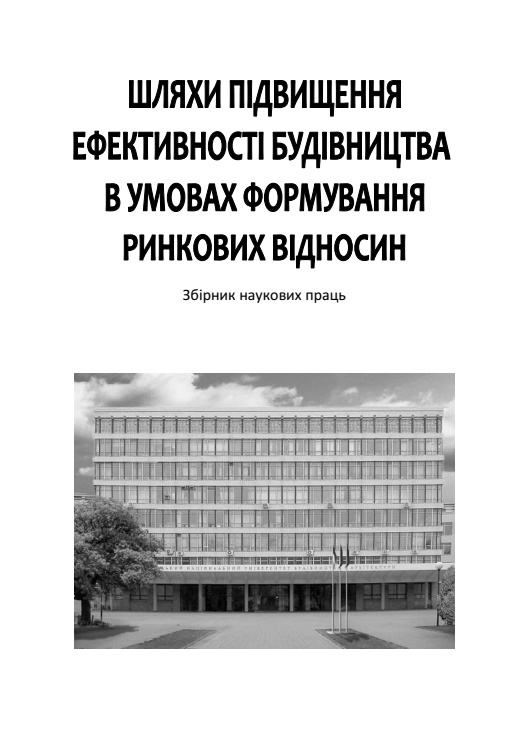Housing affordability for households: methodological aspects and institutional factors
DOI:
https://doi.org/10.32347/2707-501x.2018.38.147-161Keywords:
construction activity, housing affordability ratio, international UN HABITAT method, ratio method, residual method.Abstract
The problems related to the formation of the affordable housing market are considered. The volume of housing construction per person in Ukraine has been analyzed. The procedure for assessing the affordability of housing for the population of Kyiv is proposed. This procedure includes the analysis of statistics in the dynamics, reflecting the living conditions of the population of Ukraine and Kiev (the volume of housing per capita, the number of apartments, the volume of commissioning of housing, the indicator of indirect cost of construction of housing, average income of the population, the number of mortgages issued credits) and the calculation of special indices. The conducted statistical analysis showed the relative inaccessibility of housing for the population of Kyiv when using their own income. An analysis of the population's own incomes showed the low ability of Kyiv families to buy their own homes. In addition, the gap between the income of Kyiv's population and housing market prices continues to widen. The analysis showed that the mortgage market is steadily developing, but due to various factors (high interest rates, insufficient average income of the population, etc.), it cannot sufficiently meet the housing needs of Kyiv's population. These findings also confirm the author's housing affordability ratios: simple affordability, affordability (including household costs). The conclusion of the article is a statement about the low availability of housing in the market of Kyiv. Price is the dominant factor in assessing the affordability of housing if the rate of increase in housing prices over a period of time is higher than the rate of increase in household income. A number of recommendations are offered to improve the housing market situation and facilitate the solution of the selected problem, namely to take measures to restrain the rise in prices in the housing market, reorienting the concept of housing market development not as a consumer product market, but as a socially necessary commodity to the population.
References
Judge, L. and Tomlinson, D. (2018). Home Improvements – Action to Address the Housing Challenges Faced By Young People. [Електронний ресурс]. – Режим доступу: https://www.resolutionfoundation.org/app/ uploads/2018/04/Home-improvements.pdf
Gabriel, M., Jacobs, K., Arthurson, K., Burke, T., Yates, J. (2005). Conceptualising and measuring the housing affordability problem, AHURI Research Paper No. NRV3-1, Australian Housing and Urban Research Institute Limited, Melbourne. [Електронний ресурс]. – Режим доступу: https://www.ahuri.edu.au/research/nrv-research-papers/nrv3-1.
Yates, J., Milligan, V. (2007). Housing affordability: a 21st century problem, AHURI Final Report No. 105, Australian Housing and Urban Research Institute Limited, Melbourne. [Електронний ресурс]. – Режим доступу: https://www.ahuri.edu.au/research/final-reports/105.
The affordability index: a new tool for measuring the true affordability of a housing choice. Washington, DC: Brookings Institution (2006). [Електронний ресурс]. – Режим доступу: https://www.brookings.edu/wp-content/uploads/2016/06/20060127_affindex.pdf.
Housing affordability: more than rents and mortgages (2008). [Електронний ресурс]. – Режим доступу: http://www.vcoss.org.au/documents/VCOSS%20docs/ Housing/REP_ACF_VCOSS%20Housing%20Affordability%20October%202008%20.PDF.
Habitat for Humanity, 2017. Affordable for Good – Building Inclusive Communities Through Homes that Last). [Електронний ресурс]. – Режим доступу: https://www.habitat.org/sites/default/files/ShelterReport2017.pdf.
Цифра Т.Ю. Впровадження світового досвіду фінансування доступного житла через систему будівельно-ощадних кас в Україні [Електронний ресурс] / Бєлєнкова О.Ю., Цифра Т.Ю., Шашко М.М. // Проблеми системного підходу в економіці: електронне наукове фахове видання. НАУ, 2010. – № 3. – Режим доступу: http://archive.nbuv.gov.ua/e-journals/PSPE/2010_3/Cifra_310.htm.
Цифра Т.Ю. Класифікація житла за типами доступності методом дискримінантного аналізу / Т.Ю. Цифра // Ефективна економіка. – 2018. [Електронний ресурс]. – Режим доступу: http://www.economy.nayka.com.ua/pdf/9_2018/43.pdf
Доходи населення за регіонами України // Офіц. веб-сайт Держ. ком. статистики України. [Електронний ресурс]. - Режим доступу: http://www.ukrstat.gov.ua/ operativ/ operativ2005/gdn/dvn_ric/dvn%20_u/dvn_u.htm
Про показники опосередкованої вартості спорудження житла за регіонами України: Наказ Мінрегіонбуду України. [Електронний ресурс]. - Режим доступу: http://www.minregion.gov.ua/napryamki-diyalnosti/building/pricing/tsinoutvorennya/
Прийняття в експлуатацію житлових будівель за видами: Головне управління статистики у м. Києві. [Електронний ресурс]. - Режим доступу: http://kiev.ukrstat.gov.ua/p.php3?c=2583&lang=1
Что показывает коефициент доступности жилья…/ Н.Косарева, А.Туманов // "Демоскоп Weeklly". – 2007. – 29 октяб. – 11 нояб. [Електронний ресурс]. – С. 307–308. – Режим доступу: www.demoscope.ru/weekly/2007/0307/ tema03.php
Saaty T.L. Fundamentals of Decision-Making and Priority Theory with the AHP. The Analytic Hierarchy Process in Natural Resource and Environmental Decision Making. 2001. Рp. 15-35
Kanapeckiene L., Kaklauskas A., Zavadskas E. K., Seniut, M. Integrated knowledge management model and system for construction projects. Engineering Applications of Artificial Intelligence. 2010. № 23. Рр. 1200–1215.
Zavadskas E.K., Turskis, Z., Volvačiovas, R., Kildiene, S. Multi-criteria assessment model of technologies. Studies in Informatics and Control. 2013. № 22. Рр. 249–258.
Zavadskas E.K., Skibniewski M.J., & Antucheviciene J. Performance analysis of Civil Engineering Journals based on the Web of Science® database. Archives of Civil and Mechanical Engineering. 2014. № 14. Рр. 519–527
Downloads
How to Cite
Issue
Section
License
Copyright (c) 2020 V. Tуtok

This work is licensed under a Creative Commons Attribution 4.0 International License.
Authors who publish with this journal agree to the following terms:
- Authors retain copyright and grant the journal right of first publication with the work simultaneously licensed under a Creative Commons Attribution License that allows others to share the work with an acknowledgement of the work's authorship and initial publication in this journal.
- Authors are able to enter into separate, additional contractual arrangements for the non-exclusive distribution of the journal's published version of the work (e.g., post it to an institutional repository or publish it in a book), with an acknowledgement of its initial publication in this journal.
- Authors are permitted and encouraged to post their work online (e.g., in institutional repositories or on their website) prior to and during the submission process, as it can lead to productive exchanges, as well as earlier and greater citation of published work (See The Effect of Open Access).

